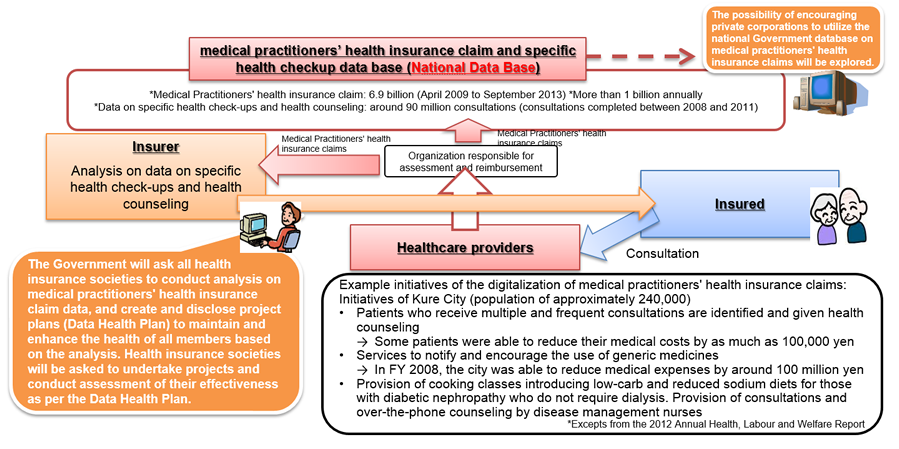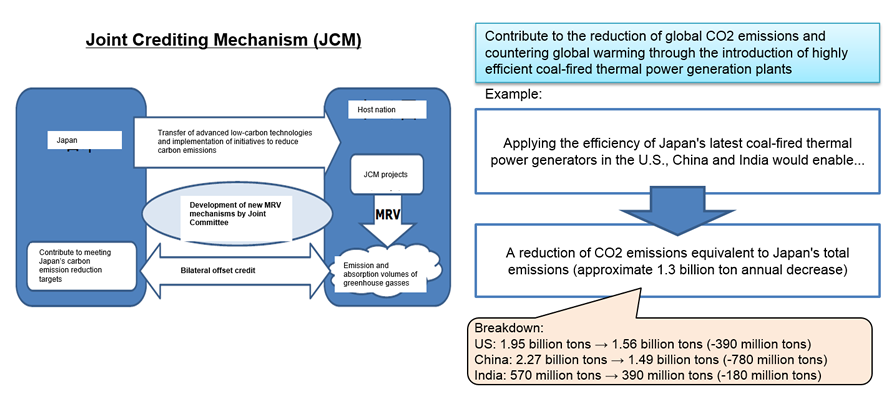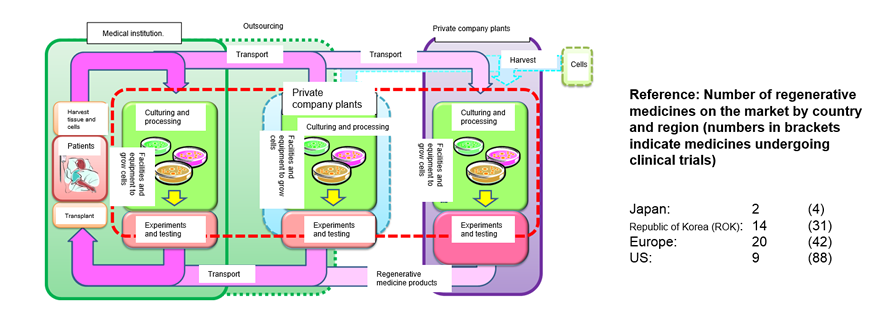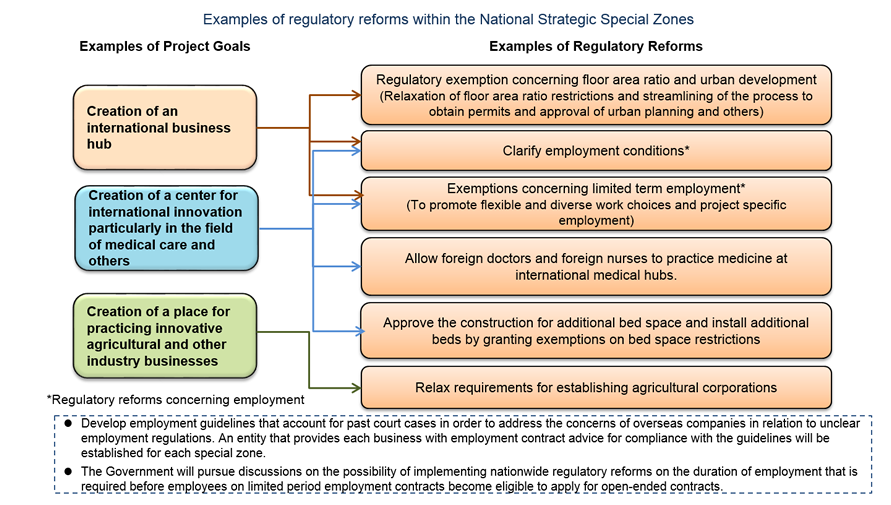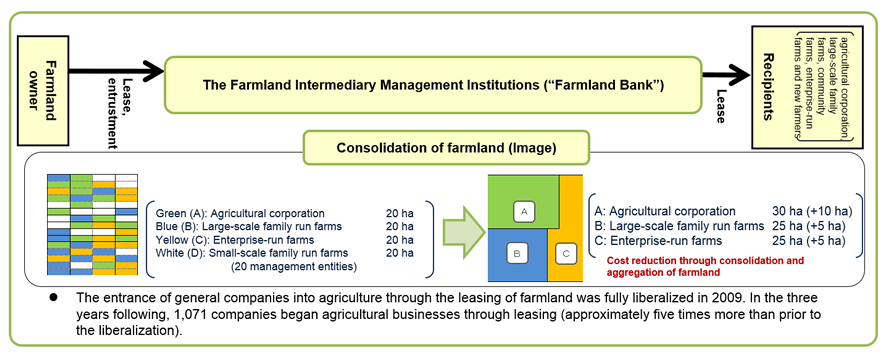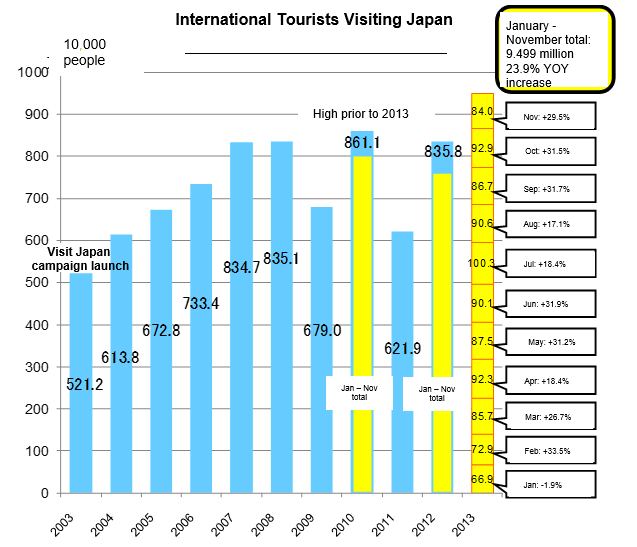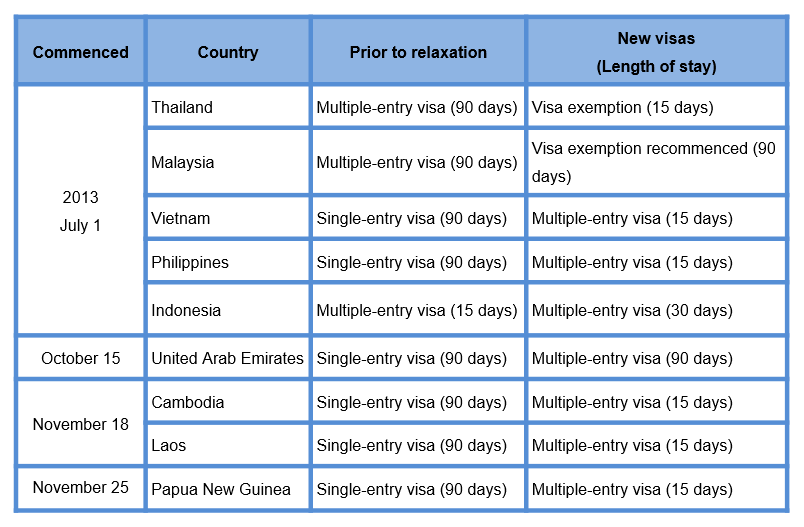- Home >
- Speeches and Policy >
- “Abenomics” is Progressing!
“Abenomics” is Progressing!
4. Examples of Individual Measures of the Third Arrow
Private Sector Structural Reform
- Promote business realignment of companies and create an environment that encourages innovative startup companies and new businesses in order to improve productivity and enhance corporate earnings.
- Support companies that shift to making proactive moves through decreasing the burden on corporations by, for instance, providing tax incentives.
- Enhancing Corporate Governance
- In order to encourage positive business management, company boards must in principle include external directors (revised Companies Act bill was submitted to the Diet in November 2013). They must also clarify the requirement for the inclusion of external directors as a requirement for being listed on the Tokyo Stock Exchange.
- Establish principles concerning fiduciary duties and corporate investors (to be finalized before the end of February 2014).
- Tokyo Stock Exchange and Nikkei announced a new stock price index, the JPX-Nikkei Index 400, which accounts for profitability and the quality of corporate governance. The new index is to be used from January.
- Revitalizing Private Sector Investment
- Establish a scheme that provides special depreciation or tax deductions for capital expenditure on leading edge equipment and facilities.
- Promoting Business Realignment
- A scheme that makes contingency reserves a tax deductible expense for those businesses that realign their businesses to improve profitability will be introduced.
- Developing an Environment that Allows People to take on Challenges
- Establish a system that grants regulatory exemptions for individual companies which conduct field-tests.

The Industrial Competitiveness Enhancement Act was enacted during the extraordinary Diet session in autumn 2013.
- Promoting Venture Capital Investment
- A bill to establish a legal system for fund-raising through crowdfunding will be submitted to the Diet in January 2014.
Promotion of the Advancement of Women's Roles in the Workforce
- Mobilize all policies to improve female (25 to 44 years of age) participation in the workforce to 73% (68% in 2012) by 2020 and increase the percentage of women in leadership positions to 30%.
(1) Infrastructure development that supports the advancement of women in the workforce (zero childcare waiting-list project) *The number of facilities and children are those of authorized childcare centers.
Secure additional childcare capacity for approximately 200,000 children by 2015 and 400,000 by 2017. *The current childcare center situation: There are approximately 24,000 centers with a total of 2.22 million children using the care facilities. There are approximately 23,000 children on childcare waiting lists.
Support Package
- (1)Open more childcare centers by utilizing a rental system and Government-owned land (infrastructure)
- (2)Secure childcare workers to sustain the growing demand (human resources)
- (3)Advanced implementation of new schemes including subsidies for small scale childcare businesses (create additional childcare capacity swiftly)
- (4)Assistance for unregistered childcare centers that are seeking registration
- (5)Support for on-site childcare centers on business premises
(2) Incentives designed to promote the advancement of women's roles in the workforce
- Support companies that encourage female employees to pursue both career and a family through subsidies or tax measures.
-
Encourage companies to disclose information concerning the promotion of women to executive and management positions. Statistics on women's positions within companies are to be disclosed on the Cabinet Office website
(http://www.gender.go.jp/english_contents/index.html)
sometime in January. - In April 2013, Prime Minister Abe himself asked company leaders to proactively promote women within their companies.
(3) Initiatives taken by the Government
- The Government is taking the initiative and being an example in recruiting and promoting women within the workforce and supporting women as they balance both their career and family life (multiple women have been promoted to top-ranking national public servant positions).
Sourcing Human Resources from Overseas
- The points-based preferential immigration system introduced in 2012 will be revised, being expected to increase the number of skilled foreign professionals entering Japan (May 2012 - April 2013: approximately 430 people).
- A greater number of international researchers will be employed as part of the national university reforms. Full-time positions of around 1,500 will be offered to young domestic and international researchers over the next three years.
Policy for the revision of the points-based preferential immigration system
Current scheme
- The categories of the activities of foreign human resources are classified into: (1) academic research, (2) advanced specialties and technical activities, and (3) management and administration. Each criterion (academic background, employment history, income, research achievement) has been set according to the nature of the activity and individuals are given points accordingly.
- When individuals reach the predetermined point level, they will be eligible for preferential immigration treatment (shortened permanent residency waiting times from 10 years to 5 years, permission to bring parents and housekeepers).

Post-reforms
- Expand the scope of compensation recognized as salary (compensation received from foreign offices can now be added to the salary)
- Raise points ceiling in the category of research achievement and award merit points for certain professional degrees (MBA and MOT)
- Loosen income requirements following the change to allow migration of parents and housekeepers
- Shorten permanent residency waiting times from 5 years to 3 years, and so on
Strengthening R&D Capacity
- Strengthen the leadership of the Council for Science and Technology Policy in order to eliminate vertical segmentation within the Government, and facilitate resource allocation as per the Growth Strategy.
- Prioritize resource allocation as per the roadmap, which accounts for complete procedures from foundational research to practical application.
- Develop a system that guarantees stable career paths for researchers.
- Cross-ministerial Strategic Innovation Promotion Program (SIP)
- A cross-ministerial program that facilitates cooperation across the boundaries of ministries and fields.
- The Council for Science and Technology Policy identifies challenges and allocates a budget accordingly.
- Impulsing PAradigm Change through disruptive Technologies (ImPACT)
- Drives high risk, high impact research and development that will bring huge paradigm change to Japan's industry, economy and society.
- Improve the career development environment for researchers
- The period of time that researchers, engineers, and so on* at universities or private companies have to work before they are eligible for an open-ended employment contract will be extended from 5 to 10 years.
- This allows young researchers and engineers to pursue their careers at multiple research institutions and take a path that is complicit with international standards where researchers and engineers and engineers are evaluated after five years (the R&D Reinforcement Act was enacted during the extraordinary Diet session in Autumn 2013).
*Researchers at private companies must be engaged in full-time joint research with a university or other institution to be eligible for this change.
Utilization of ICT in Healthcare and Medical Services
-
The utilization of ICT in the fields of medicine, aged care and preventative healthcare will be accelerated. Preventative health care and optimization of health care spending are encouraged.
resource allocation as per the Growth Strategy. - An ID system will be introduced in 2016 for taxation and social security purposes. The efficiency and speed of administrative services are to be enhanced.
- The Government CIO will drive digital administrative services. Public information such as geospatial data and statistics will be made easily publicly accessible to support the creation of new businesses.
Example initiatives in the field of medical services: Digitalization of medical practitioners' health insurance claims, creation of the Data Health Plan
Expansion of Utilization of PPP and PFI
- Funnel private sector funds and expertise into the development of infrastructure that is traditionally dominated by the public sector. This will not only allow for effective and efficient development and management, but it will also provide private companies with a huge market and opportunities to strengthen their international competitiveness.
- Focus will be on altering the perception that owners and managers must be the same. Concession agreements that enable independent management of public facilities by private enterprises will be promoted.
- Expand the size of PPP/PFI to 12 trillion yen over the next 10 years (currently 4.1 trillion yen).
|
Expanding Eligibility for Concession Agreements The introduction of a public facility management rights scheme (concession agreements) that allow private enterprises to run pubic facilities will be encouraged
Examples: |
|
|---|---|
|
Using private funds to counter the issue of the dilapidation of the Metropolitan Expressway Promote PPP projects by for instance, utilizing space above roads to address the issue of dilapidation of the Metropolitan Expressway and encourage private sector urban development simultaneously (a pilot project is underway for the section of the Metropolitan Expressway near Tsukiji River). |
Utilization of Highly Efficient Thermal Power Generation
- Enhancing the efficiency of coal-fired thermal power generation is the key to ensuring sufficient electricity supply throughout the world and contributing to minimizing global warming. In 2010, coal-fired thermal power generation accounted for more than 40% of the world's electricity generation.
- The coal-fired thermal power generation technology used in Japan is some of the most advanced in the world and facilitates efficient electricity generation. The Government will proactively export this technology to other parts of the world. The greenhouse gas emission reduction target for COP19 (3.8% reduction of FY 2005 emissions) accounts for the bilateral offset credits that will be earned through the transfer of energy-saving technologies to other countries.
- Clarify and expedite environmental impact assessment procedures to create an environment that facilitates smooth investment by private enterprises in highly efficient thermal power generation (e.g. reduce the duration of procedures required for the replacement of thermal power plants from the usual three years to one year).
Promotion of the Commercialization of Regenerative Medicine
The 2013 Autumn extraordinary Diet session approved a bill to ensure the safety of regenerative medicine and other relevant bills. They have enabled the creation of an environment that facilitates the swift and safe commercialization of various regenerative medical technologies.
Example initiative: Agenda items adopted by the Highway Program for Realization of Regenerative Medicine (commencement of clinical trials on these agenda items is targeted within one to three years)
- The development of treatments for age-related macular degeneration by transplanting iPS cell-derived cells of the retinal pigment epithelium
- The regeneration of knee meniscus by using synovium stem cells
- The development of minimally invasive treatments for liver regeneration by using cultured human bone marrow cells
- The development of corneal endothelium regeneration treatments by transplanting cultured human corneal endothelium cells
Development of regulation that accounts for the nature of regenerative medicine
Enable medical institutions to outsource the growth and maturation of cells. Also, introduce an accelerated approval scheme that enables the conditional and limited time commercialization of medicines once their effectiveness and safety has been confirmed by a certain number of case studies.
Establishment of the National Strategic Special Zones
- The Prime Minister, the Minister in charge of the National Strategic Special Zone and other cabinet members will take the initiative in designating special zones. They will also be responsible for determining the enforcement of the zone-specific regulatory preferential treatment. The extraordinary Diet session in autumn 2013 approved the legal framework to facilitate this.
- It is expected that this will be a breakthrough that sees the implementation of bold regulatory reforms.
Efficient use of Farmland (consolidation and aggregation of farmland)
- Pursue consolidation and aggregation of farmland for the next generation of farmers including agricultural corporations, large-scale family farms, community farms, and enterprise-run farms. Through these initiatives, the Government will aim to increase the number of farms run by corporations by a factor of four compared to 2010 over the next 10 years.
- In order to advance agricultural reforms and reduce production costs, prefectural intermediary institutions that manage farmland will be established in each prefecture in order to consolidate the fragmented farmland ownership. The extraordinary Diet session in autumn 2013 approved the legal framework to facilitate this.
Target
Ensure that at least 80% of all farmland in Japan is used by next-generation farmers over the next 10 years (reduce costs through the aggregation and consolidation of farmland).
Scheme
Attracting International Tourists
- Attracting international tourists, particularly from ASEAN nations through the loosening of visa requirements. Pursuing discussions on the introduction of a scheme that enables foreign nationals (particularly wealthy individuals) who meet certain criteria to stay in Japan for an extended period of time.
- Through these initiatives, the Government has successfully attracted 10 million international travelers in 2013 and is working toward attracting more than 30 million international tourists annually by 2030 (2012: 8.36 million international tourists).
International Tourists Visiting Japan
International Tourists Visiting Japan
Consumption Tax Exemptions for International Tourists
Beginning in October 2014, items exempt from consumption tax for international tourists will be expanded to include consumable goods such as food and cosmetics. Tax exemption procedures were also simplified.








